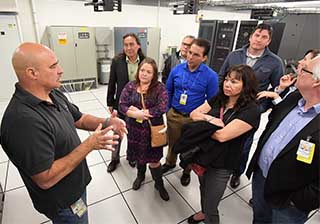Eastern Cherokees explore IT and partnership at Sandia

BIG DATA — David Martinez (9324), project lead for Scientific Computing Systems, gives members of the Eastern Band of Cherokees delegation a tour of Sandia’s Data Center. Tribal Vice Chief Richard Sneed (center in the blue shirt) says he was impressed by the center’s water-cooled system. “It’s counterintuitive — water and circuitry — but when you learn how much energy is saved using water to cool everything instead of air, it is just amazing,” he says. (Photo by Randy Montoya)
The Eastern Band of the Cherokee Indians is considering an alliance with Sandia that could take its information technology system to a higher level and potentially spur economic development.
Tribal representatives toured the Labs on Jan. 25, visiting the Cyber Engineering Research Laboratory (CERL) and the Data Center. “It was a wonderful experience,” says Anita Lossiah, a Tribal Council member from the Yellowhill community in western North Carolina. “It was a learning experience to see what Sandia has to offer the tribe, very informative.”
Vice Chief Richard Sneed says the Eastern Cherokees want to enhance and advance the tribal government IT infrastructure with a focus on cybersecurity, emergency management, and data center systems. “If we were to enter into a relationship with Sandia we could implement best practices that are known and have been tested,” he says. “It could serve our people better to partner on the front end instead of starting from scratch.”
Andrew Conseen Duff, technology adviser to the Tribal Council, says it is important that IT infrastructure meet industry-based standards and be secure and defendable. “We want to remove vulnerabilities,” he says. “Information used wrongly can be devastating.”
IT a trillion-dollar business
Sneed says enhanced IT could produce economic development opportunities in the Internet and emergency response fields. “IT is a trillion dollar business across the globe,” he says. “If our tribe builds a solid infrastructure we can look to a clear roadmap into new areas that could be a boon for economic development.”
Conseen Duff says the Eastern Cherokee delegation heard the word opportunity spoken often during the Sandia presentations. “Every time I heard it, I listened closely,” he says.
Sneed says government is often reactive instead of proactive. He says he was inspired by the Sandia scientists who spoke to his group. “Just to know there are folks who spend every waking hour engaged in research and development is encouraging from a government perspective,” he says. “It would be beneficial and more cost-effective to be able to not be reactive but to have a plan knowing what the outcome is going to be. IT is not an area where you want to be wrong.”
Modernization, protection, security, resilience
Curtis Keliiaa (9336), principal investigator for Tribal Cyber Infrastructure Assurance, says Sandia’s tribal strategic partnerships address national and tribal cyber critical infrastructure challenges regarding modernization, protection, security, and resilience. His team has developed eight deep science, engineering, and technical interdisciplinary abilities drawn from across Sandia and designed to apply to the 16 Department of Homeland Security defined critical infrastructure sectors.
Curtis says his group, in coordination with Tribal Government Relations, has worked with or is currently working with tribes in the western, northwest, and southwest United States. “The Eastern Band of Cherokee Indians visit to Sandia was very well received and provides potential opportunity to work in the eastern region of the United States to the mutual benefit of the nation and the tribe,” he says.
Sneed and Lossiah say the next step is to take what they’ve learned back to the tribe and review and discuss the partnership potential.
Sneed says the Eastern Cherokees have new executive and Tribal Council leadership and are looking to a dynamic future. “We’re on the precipice of a lot of growth potential,” he says. “We want to see where we can go with infrastructure. If we have a solid foundation we can go to many other places. We feel an energy. It’s an exciting time for the tribe.”